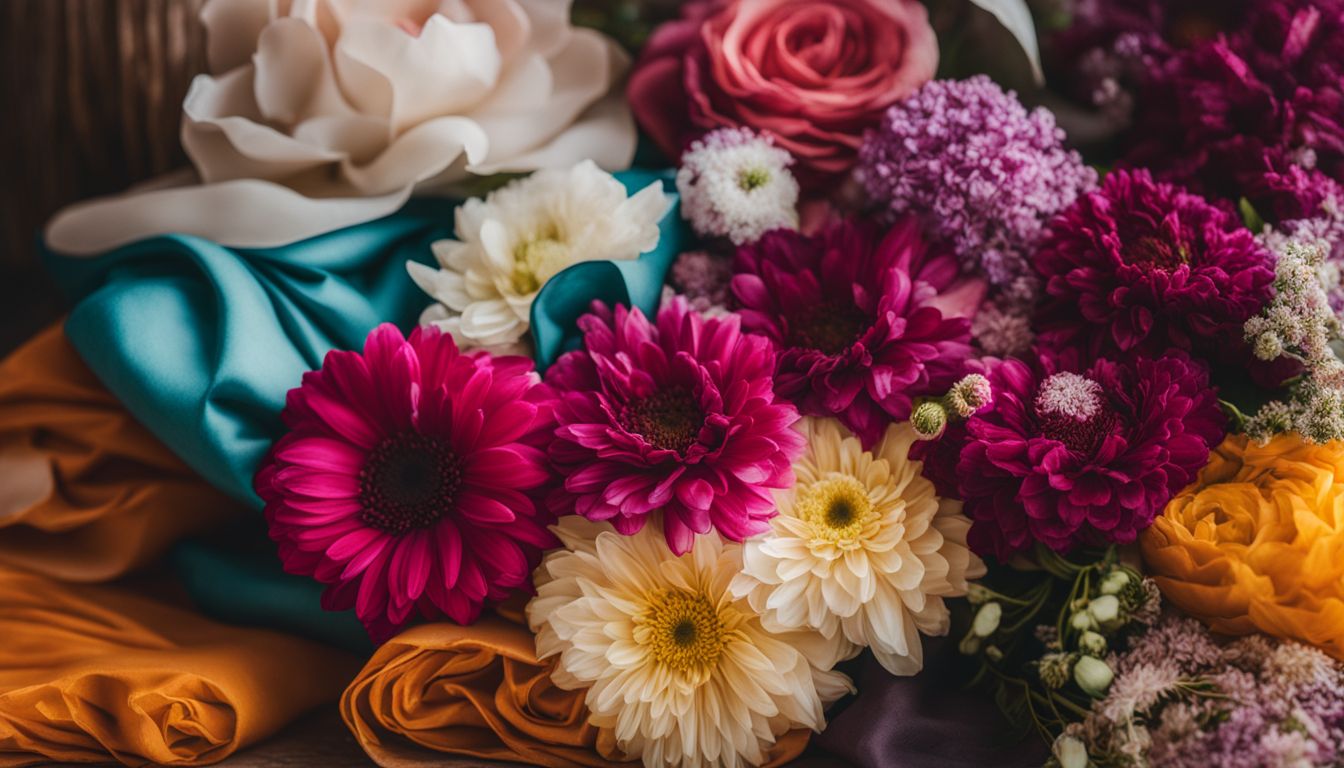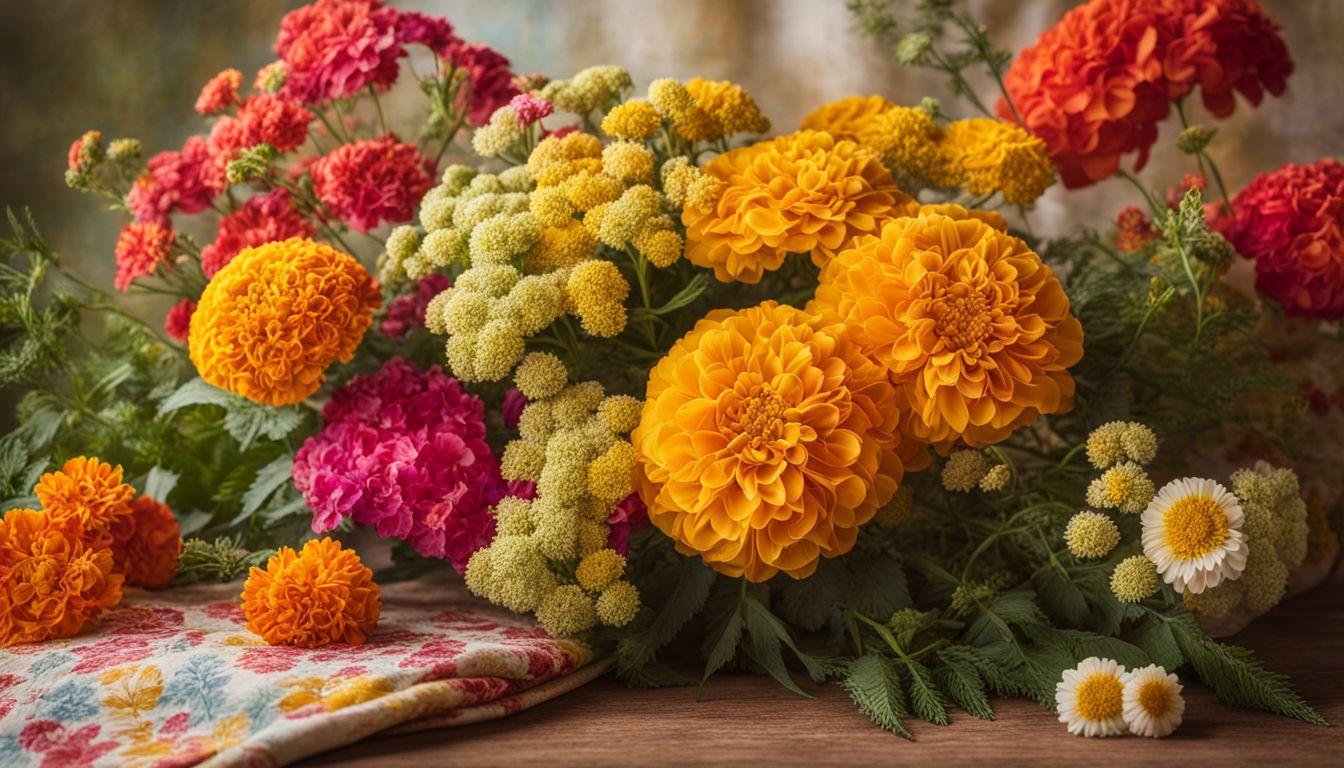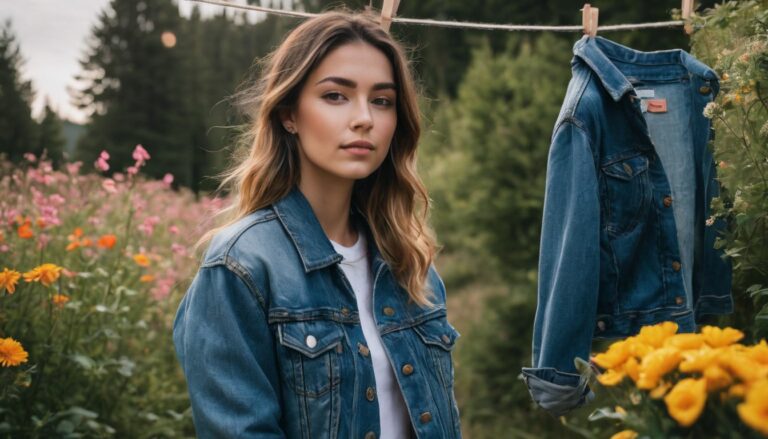Say Goodbye to Boring Outfits: Learn How To dye clothes with flowers
Dyeing your clothes can be an exciting way to add some personality to your wardrobe, but have you ever thought of using flowers for this task? Flowers, abundant with natural pigments, present an eco-friendly alternative to synthetic dyes.
This blog will guide you through the enchanting journey of fabric dyeing with flowers – from picking the right blooms to creating beautiful patterns on your garments. Let’s dive in and explore this fascinating world of botanic hues together!
Key Takeaways
- Flower dyeing is an eco – friendly alternative to synthetic dyes, using natural pigments from flowers to add color to your clothes.
- To dye clothes with flowers, you will need fabric (preferably natural materials), fresh flowers or plant materials, alum as a mordant, and containers for water and dye bath.
- The process involves preparing the fabric, collecting and preparing the flowers or plant materials, creating a dye bath by boiling the flowers and water, soaking the fabric in the dye bath for several hours or overnight, rinsing and drying the dyed fabric properly.
- Marigold, goldenrod, hydrangeas, dyer’s chamomile are some of the best flowers for dyeing fabric due to their vibrant colors and ability to transfer pigment effectively.
What is Flower Dyeing?
Flower dyeing is the process of transferring color from flowers to fabric, providing an eco-friendly alternative to synthetic dyes.
Process of transferring color from flowers to fabric

First, pick your flowers. The dye comes from the flower’s color. You need many flowers to get a lot of dye. Then, wash your fabric. Put it in hot water with alum for an hour. Alum helps the fabric soak up the dye.
Next, put your flowers in a pot and add water. Boil them until you get a strong color in the water – this is your dye bath! Take out all the bits of flower so only colored water is left.
Now, take your fabric out of the alum water and squeeze it dry. Place this fabric into the hot flower dye bath.
Let it sit for some hours or even overnight.
After time has passed, take out your fabric from the dye bath but do not rinse yet; let it air dry first.
Once fully dry then you can rinse off any extra dyed parts under cold running water till clear. Finally hang to dry again before using.
This process will give you nicely dyed clothes with beautiful colors from nature!
Eco-friendly alternative to synthetic dyes

Using natural dyes from flowers is an eco-friendly alternative to synthetic dyes. Synthetic dyes are made using chemicals that can harm the environment and pollute water sources. On the other hand, flower dyeing uses plant materials that are safer for the planet.
By opting for flower dyeing, you can reduce your carbon footprint and contribute to a more sustainable fashion industry. Plus, natural dyes create beautiful and unique colors on fabric, adding a touch of nature to your wardrobe.
So next time you want to add color to your clothes, consider using flowers instead of synthetic dyes!
Supplies Needed for Flower Dyeing

To dye clothes with flowers, you will need fabric (preferably natural materials), fresh flowers or plant materials, alum as a mordant, and containers for water and dye bath.
Fabric (natural materials work best)
-3778e5ef33-890962611.jpg)
Natural fabrics are the best choice for flower dyeing. Fabrics like cotton, linen, silk, and wool work well because they can absorb the color from the flowers easily. These natural materials allow for better dye penetration and create vibrant and long-lasting colors on clothes.
Synthetic fabrics like polyester or nylon may not hold onto the flower dyes as effectively. So if you want to get the most out of your flower dyeing experience, opt for natural fabrics that will give you beautiful results!
Fresh flowers or plant materials
You will need fresh flowers or plant materials to dye your clothes naturally. Some popular choices include marigolds, goldenrods, hydrangeas, dyer’s chamomile, and roses. Different flowers produce different colors when used for dyeing.
You can collect these flowers from your garden or purchase them from a local florist. It’s important to use natural materials for the best results in flower dyeing. These fresh flowers will be boiled to create a dye bath that you can soak your fabric in to transfer the color.
This is a sustainable and eco-friendly way to add beautiful colors to your clothes!
Alum (mordant)
Alum, also known as a mordant, is an important ingredient when dyeing clothes with flowers. It helps to fix the color of the dye onto the fabric and improve its wash-fastness. Alum is a naturally occurring mineral that can be purchased in powdered form.
Before dyeing, you will need to prepare your fabric by washing it and then mordanting it with alum. This process involves soaking the fabric in hot water mixed with alum, which allows the fibers to absorb and hold onto the dye more effectively.
By using alum as a mordant, you can create vibrant and long-lasting colors when dyeing clothes with flowers.
Water and containers

You will need water and containers for the flower dyeing process. Water is essential as it is used to create the dye bath that extracts the color from the flowers. You can use tap water or rainwater for this purpose.
Containers are needed to hold the dye bath and fabric during soaking. These containers can be pots, buckets, or any other heat-resistant vessels that are big enough to accommodate both the flowers and fabric.
Remember to choose non-reactive containers made of stainless steel or enamel, as some metals can affect the color of your dye. It’s also important to have enough water to fully immerse your fabric in the dye bath and allow it to soak properly.
Steps for Flower Dyeing

Prepare the fabric, collect and prepare the flowers or plant materials, create a dye bath, strain and add the fabric, let it soak, rinse and dry – learn how to dye clothes with flowers in this blog post.
Prepare the fabric by washing and mordanting

Before dyeing your fabric with flowers, it’s important to prepare it properly. Start by washing the fabric with mild detergent to remove any dirt or oils that could hinder the dye absorption.
After washing, soak the fabric in a mordant solution made with alum and water. Alum acts as a fixative to help the flower dye adhere better to the fabric and improve colorfastness.
Allow the fabric to soak in the mordant solution for at least an hour before removing and rinsing thoroughly. Once your fabric is washed and mordanted, it’s ready for the next step of flower dyeing!
Collect and prepare the flowers or plant materials

To start dyeing your clothes with flowers, the first step is to collect and prepare the flowers or plant materials you will use. Look for fresh flowers in your garden or nearby fields.
Popular choices include marigolds, goldenrods, hydrangeas, geraniums, roses, and coreopsis. Once you have gathered your chosen flowers, make sure to wash them gently to remove any dirt or debris.
Next, prepare the fabric by washing it as well to ensure a clean surface for dye absorption. Natural fabrics like cotton and linen work best for flower dyeing. By collecting and preparing both the flowers and fabric carefully, you’ll be ready to dive into the colorful world of natural plant dyes!
Create a dye bath by boiling the flowers and water
To create a dye bath, you’ll need to boil the flowers and water together. This helps extract the color from the flowers and transfer it onto your fabric. You can use different types of flowers like marigold, goldenrod, hydrangeas, or dyer’s chamomile.
Each flower will give different colors to your clothes. After boiling the flowers and water for some time, strain the mixture to remove any solid parts. Then add your fabric into the dye bath and let it soak for several hours or even overnight.
This allows the fabric to absorb the natural color from the flowers. Finally, rinse out any excess dye and let your newly dyed fabric dry completely before using or wearing it.
Strain the dye bath and add the fabric
After boiling the flowers and water to create a dye bath, it’s important to strain the liquid to remove any solid particles. This will ensure a smooth and even coloring process. Once strained, carefully add your fabric into the dye bath.
Make sure that the fabric is fully submerged so it can absorb the color properly. Allow the fabric to soak in the dye bath for several hours or overnight, depending on how intense you want the color to be.
Remember, different flower species produce different colors, so choose your flowers accordingly for your desired hue!
Let the fabric soak in the dye bath for several hours or overnight

After preparing the dye bath by boiling the flowers and water, it’s time to let your fabric soak in it. This step allows the fabric to absorb the beautiful colors from the flowers.
Make sure to give it enough time, either several hours or even leave it overnight for richer hues. The longer you let it soak, the stronger and more vibrant the color will be. So go ahead and let nature work its magic on your fabric!
Rinse and dry the dyed fabric

After the fabric has soaked in the dye bath for several hours or overnight, it’s time to rinse and dry it. Gently remove the fabric from the dye bath and rinse it under cool water until the water runs clear.
This helps to remove any excess dye that hasn’t fully absorbed into the fabric. Once rinsed, carefully squeeze out any remaining water without wringing or twisting the fabric too much.
Next, lay your dyed fabric flat on a clean towel or hang it up to air dry. It’s important to avoid direct sunlight as this can cause fading of the colors. Allow your fabric to dry completely before using or wearing it.
Best Flowers for Dyeing Fabric

Marigold, goldenrod, hydrangeas, dyer’s chamomile, and geraniums are some of the best flowers for dyeing fabric due to their vibrant colors and ability to transfer pigment effectively.
Marigold

Marigolds are one of the best flowers to use when dyeing clothes naturally. They produce a vibrant yellow color that can range from light to deep shades. Marigold dye is easy to create by boiling the flower petals in water.
This dye can be used on various fabrics, including cotton and linen. When soaked in the marigold dye bath, the fabric absorbs the beautiful yellow color, resulting in unique and eco-friendly clothing.
Using marigolds for flower dyeing is a great way to add a pop of color to your wardrobe while being environmentally conscious.
Goldenrod

Goldenrod is a beautiful flower that can be used to create natural dyes for fabric. When boiled, goldenrod produces a vibrant yellow dye that can add a pop of color to your clothes.
With its bright and cheerful hue, goldenrod is often used in eco printing and immersion dyeing techniques. This flower is particularly popular among those who want to create sustainable and environmentally friendly colors on their clothes.
So, if you’re looking for a natural way to dye your fabric with a sunny yellow shade, consider giving goldenrod a try!
Hydrangeas
Hydrangeas are beautiful flowers that can be used to dye clothes naturally. They have petals that produce a range of colors, including blue, pink, and purple. When using hydrangeas for flower dyeing, it’s important to choose fresh blooms with vibrant petals.
By boiling the hydrangea flowers in water and then soaking the fabric in the resulting dye bath, you can transfer their color onto your clothes. This process allows you to create unique and eco-friendly designs on your garments.
So next time you see hydrangeas blooming in your garden or at a flower shop, consider using them to add some natural beauty to your wardrobe!
Dyer’s chamomile
Dyer’s chamomile is one of the flowers commonly used for dyeing clothes. It produces a beautiful yellow color that can add a sunny touch to your fabric. This flower is easy to grow and its petals can be boiled to create a dye bath.
Simply soak your fabric in the dye bath and let it absorb the color for several hours or overnight. Dyer’s chamomile is a great option if you’re looking for a natural and eco-friendly way to dye your clothes with flowers.
Geraniums
Geraniums are another type of flower that can be used to dye clothes. When boiled with water, geraniums release a vibrant pink color that can be transferred onto fabric. This makes them a popular choice for creating beautiful and unique designs on clothing.
Geranium dyeing is an eco-friendly alternative to synthetic dyes because it utilizes natural ingredients from the garden. By using geraniums to dye your clothes, you can enjoy the beauty of nature while also being kind to the environment.
Roses
Roses are not only beautiful flowers but can also be used to dye clothes naturally. When using roses for dyeing fabric, you can achieve shades of pink and red. Additionally, rose petals can be used to create delicate imprints on fabric through a technique called eco printing.
By boiling the petals and soaking the fabric, you can transfer the color onto the cloth. Roses are a great option for adding natural colors to your clothes in an eco-friendly way.
Coreopsis
Coreopsis is another flower that can be used to dye clothes. It produces vibrant shades of yellow and orange, making it a popular choice for adding bright colors to fabrics. When using coreopsis for dyeing, the flowers are typically boiled in water to extract their color.
The fabric is then soaked in the dye bath for several hours or overnight to absorb the pigment. Coreopsis is a great option for those looking to create beautiful and sustainable colors on their clothes using natural dyes.
Weld
Weld is a popular flower used for dyeing clothes. It produces vibrant yellow hues that can range from golden to chartreuse. When using weld for dyeing, the flowers are boiled in water to extract the color.
Then, the fabric is soaked in this dye bath to absorb the beautiful yellow pigment. Weld is known for its lightfastness, meaning that the color will remain vibrant even after exposure to sunlight.
This makes it a great choice for dyeing clothes if you want long-lasting and bright colors. So next time you’re looking to add some sunny shades to your wardrobe, consider using weld as a natural dye option!
Conclusion: Enjoy the beauty and uniqueness of your hand-dyed clothes using flowers
Discover the magic of dyeing clothes with flowers and embrace the beauty it brings to your wardrobe. With a few simple steps, you can create unique and eco-friendly designs that are both sustainable and stunning.
Let your creativity bloom as you explore the world of flower dyeing and enjoy the vibrant colors that nature has to offer.
FAQs
1. Can I dye clothes with flowers?
Yes, you can dye clothes with certain types of flowers that contain natural dyes.
2. How do I dye clothes with flowers?
To dye clothes with flowers, you need to extract the color from the petals by boiling them in water, then soak the fabric in the flower-infused liquid and let it sit for a period of time for the color to transfer.
3. What type of clothing works best for flower dyeing?
Natural fibers like cotton, linen, silk or wool are best suited for flower dyeing as they absorb the colors more effectively.
4. Are there any precautions I should take when dyeing clothes with flowers?
It’s important to ensure that the flowers you use are safe and non-toxic for skin contact. Additionally, protect your work surfaces from stains and always follow proper safety guidelines when handling hot liquids.







